Effect of Enrichment Items on the Physiology and Behavior of Sows in the Third Trimester of Pregnancy
Abstract
Simple Summary
Abstract
1. Introduction
2. Materials and Methods
2.1. Animals, Facilities, and Management
2.2. Enrichment Items and Treatment Schedule
2.3. Behavior Recording
2.4. Reproductive Performance Measurement
2.5. Saliva Collection
2.6. Data Analysis
3. Results
3.1. Effect of Enrichment Items on Posture Behavior
3.2. Effect of Enrichment Items on Ingestion and Stereotypic Behavior
3.3. Effect of Enrichment Items on Manipulation Behavior
3.4. Effect of Enrichment Items on Cortisol, IgA and TNF-α in Saliva
3.5. Effect of Enrichment Items on Reproductive Performance of Sows
4. Discussion
4.1. The Effect of Enrichment Items on the Behavior of Pregnant Sows
4.2. Welfare Enrichment Items Selection Preference for Sows in the Third Trimester of Pregnancy
4.3. The Effect of Enrichment Items on the Physiological Indexes in Saliva of Sows
4.4. The Effect of Enrichment Items on the Reproductive Performance of Sows
5. Conclusions
Supplementary Materials
Author Contributions
Funding
Institutional Review Board Statement
Informed Consent Statement
Data Availability Statement
Conflicts of Interest
References
- Chapinal, N.; Torre, J.L.R.D.L.; Cerisuelo, A.; Gasa, J.; Baucells, M.D.; Coma, J.; Vidal, A.; Manteca, X. Evaluation of welfare and productivity in pregnant sows kept in stalls or in 2 different group housing systems. J. Vet. Behav. Clin. Appl. Res. 2010, 5, 82–93. [Google Scholar] [CrossRef]
- Kallio, P.A.; Janczak, A.M.; Valros, A.E.; Edwards, S.A.; Heinonen, M. Case control study on environmental, nutritional and management-based risk factors for tail-biting in long-tailed pigs. Anim. Welf. 2018, 27, 21–34. [Google Scholar] [CrossRef]
- Kittawornrat, A.; Zimmerman, J.J. Toward a better understanding of pig behavior and pig welfare. Anim. Health Res. Rev. 2011, 12, 25–32. [Google Scholar] [CrossRef] [PubMed]
- Scollo, A.; Contiero, B.; Gottardo, F. Frequency of tail lesions and risk factors for tail biting in heavy pig production from weaning to 170 kg live weight. Vet. J. 2016, 207, 92–98. [Google Scholar] [CrossRef]
- Beattie, V.E.; O’Connell, N.E.; Moss, B.W. Influence of environmental enrichment on the behaviour, performance and meat quality of domestic pigs. Livest. Prod. Sci. 2000, 65, 71–79. [Google Scholar] [CrossRef]
- Hill, J.D.; Mcglone, J.J.; Fullwood, S.D.; Miller, M.F. Environmental enrichment influences on pig behavior, performance and meat quality. Appl. Anim. Behav. Sci. 1998, 57, 51–68. [Google Scholar] [CrossRef]
- Yang, C.H.; Ko, H.L.; Hofmann, L.S.; Llonch, L.; Manteca, X.; Camerlink, I.; Llonch, P. Pre-weaning environmental enrichment increases piglets’ object play behaviour on a large scale commercial pig farm. Appl. Anim. Behav. Sci. 2018, 202, 7–12. [Google Scholar] [CrossRef]
- Nowicki, J.; Swierkosz, S.; Tuz, R.; Schwarz, T. The influence of aromatized environmental enrichment objects with changeable aromas on the behaviour of weaned piglets. Vet. Arh. 2015, 85, 425–435. [Google Scholar]
- Mormède, P.; Andanson, S.; Aupérin, B.; Beerda, B.; Guémené, D.; Malmkvist, J.; Manteca, X.; Manteuffel, G.; Prunet, P.; Reenen, C.G.V. Exploration of the hypothalamic-pituitary-adrenal function as a tool to evaluate animal welfare. Physiol. Behav. 2007, 92, 317–339. [Google Scholar] [CrossRef]
- Cook, N.J.; Hayne, S.M.; Rioja-Lang, F.C.; Schaefer, A.L.; Gonyou, H.W. The collection of multiple saliva samples from pigs and the effect on adrenocortical activity. Can. J. Anim. Sci. 2013, 93, 329–333. [Google Scholar] [CrossRef][Green Version]
- Kirschbaum, C.; Hellhammer, D.H. Salivary cortisol in psychoneuroendocrine research: Recent developments and applications. Psychoneuroendocrinology 1994, 19, 313–333. [Google Scholar] [CrossRef]
- Muneta, Y.; Yoshikawa, T.; Minagawa, Y.; Shibahara, T.; Maeda, R.; Omata, Y. Salivary IgA as a useful non-invasive marker for restraint stress in pigs. J. Vet. Med. Sci. 2010, 72, 1295–1300. [Google Scholar] [CrossRef] [PubMed]
- Zhang, M.Y.; Li, X.; Zhang, X.H.; Liu, H.G.; Li, J.H.; Bao, J. Effects of confinement duration and parity on behavioural responses and the degree of psychological fear in pregnant sows. Appl. Anim. Behav. Sci. 2017, 179, 369–376. [Google Scholar] [CrossRef]
- S-145 Committee on Nutritional Systems for Swine to Increase Reproductive Efficiency. Effects of additional feed during late gestation on reproductive performance of sows: A cooperative study. J. Anim. Sci. 1989, 67, 3–14. [Google Scholar] [CrossRef]
- Koketsu, Y.; Iida, R. Sow housing associated with reproductive performance in breeding herds. Mol. Reprod. Dev. 2017, 84, 979–986. [Google Scholar] [CrossRef]
- King, R.L.; Matheson, S.M.; Baxter, E.M.; Edwards, S.A. Sow behaviour and piglet weight gain after late cross-fostering in farrowing crates and pens. Animal 2020, 14, 1923–1933. [Google Scholar] [CrossRef]
- Yi, R.; Wang, C.; Zhang, X.; Zhao, P.; Zhang, M.; Li, X.; Cui, S.; Liu, H.; Bao, J. Maternal Behavior, Posture Change, and Production Performance of Lactating Sows Housed in an Enriched Environment. J. Appl. Anim. Welf. Sci. 2019, 22, 298–308. [Google Scholar] [CrossRef]
- Kim, J.S.; Jang, W.S.; Bae, M.J.; Park, S.; Lee, S.S. Radiation-induced eosinophilic, polymorphic, and pruritic eruption in a pig skin model. Lab. Anim. Res. 2015, 31, 204–208. [Google Scholar] [CrossRef]
- Wood-Gush, D.G.M.; Beilharz, R.G. The enrichment of a bare environment for animals in confined conditions. Appl. Anim. Ethol. 1983, 10, 209–217. [Google Scholar] [CrossRef]
- Jarvis, S.; Van der Vegt, B.J.; Lawrence, A.B.; McLean, K.A.; Deans, L.A.; Chirnside, J.; Calvert, S.K. The effect of parity and environmental restriction on behavioural and physiological responses of pre-parturient pigs. Appl. Anim. Behav. Sci. 2001, 71, 203–216. [Google Scholar] [CrossRef]
- Mason, G.J. Stereotypies: A Critical Review. Anim. Behav. 1991, 41, 1015–1037. [Google Scholar] [CrossRef]
- Terlouw, C.E.M.; Lawrence, A.B.; Ladewig, J. Relationship between plasma cortisol and stereotypic activities in pigs. Behav. Processes 1991, 25, 133–153. [Google Scholar] [CrossRef]
- Jang, S.-E.; Ryu, K.-R.; Park, S.-H.; Chung, S.; Teruya, Y.; Han, M.J.; Woo, J.-T.; Kim, D.-H. Nobiletin and tangeretin ameliorate scratching behavior in mice by inhibiting the action of histamine and the activation of NF-κB, AP-1 and p38. Int. Immunopharmacol. 2013, 17, 502–507. [Google Scholar] [CrossRef] [PubMed]
- Li, D.; Zhang, K.; Li, Z.; Chen, Y. A Spatiotemporal Convolutional Network for Multi-Behavior Recognition of Pigs. Sensors 2020, 20, 2381. [Google Scholar] [CrossRef] [PubMed]
- Norscia, I.; Collarini, E.; Cordoni, G. Anxiety Behavior in Pigs (Sus scrofa) Decreases Through Affiliation and May Anticipate Threat. Front. Vet. Sci. 2021, 8, 630164. [Google Scholar] [CrossRef] [PubMed]
- Luo, L.; Reimert, I.; Middelkoop, A.; Kemp, B.; Bolhuis, J.E. Effects of Early and Current Environmental Enrichment on Behavior and Growth in Pigs. Front. Vet. Sci. 2020, 7, 268. [Google Scholar] [CrossRef]
- Pedersen, L.J.; Damm, B.I.; Marchant-Forde, J.N.; Jensen, K.H. Effects of feed-back from the nest on maternal responsiveness and postural changes in primiparous sows during the first 24 h after farrowing onset. Appl. Anim. Behav. Sci. 2003, 83, 109–124. [Google Scholar] [CrossRef]
- Mcglone, J.J.; Morrow-Tesch, J. Productivity and Behavior of Sows in Level vs. Sloped Farrowing Pens and Crates. J. Anim. Sci. 1990, 68, 82–87. [Google Scholar]
- Newberry, R.C. Environmental enrichment: Increasing the biological relevance of captive environment. Appl. Anim. Behav. Sci. 1995, 44, 229–243. [Google Scholar] [CrossRef]
- Weerd, H.; Day, J. A review of environmental enrichment for pigs housed in intensive housing systems. Appl. Anim. Behav. Sci. 2009, 116, 1–20. [Google Scholar] [CrossRef]
- Telkanranta, H.; Valros, A. Pigs with but not without access to pieces of recently harvested wood show reduced pen-mate manipulation after a provision of feed and straw. Appl. Anim. Behav. Sci. 2020, 232, 105103. [Google Scholar] [CrossRef]
- Vanderhaeghe, C.; Dewulf, J.; de Kruif, A.; Maes, D. Non-infectious factors associated with stillbirth in pigs: A review. Anim. Reprod. Sci. 2013, 139, 76–88. [Google Scholar] [CrossRef] [PubMed]
- Munsterhjelm, C.; Valros, A.; Heinonen, M.; Hälli, O.; Siljander-Rasi, H.; Peltoniemi, O.A.T. Environmental enrichment in early life affects cortisol patterns in growing pigs. Anim. Int. J. Anim. Biosci. 2010, 4, 242–249. [Google Scholar] [CrossRef] [PubMed]
- Ciepielewski, Z.M.; Stojek, W.; Borman, A.; Myślińska, D.; Glac, W.; Kamyczek, M. Natural killer cell cytotoxicity, cytokine and neuroendocrine responses to opioid receptor blockade during prolonged restraint in pigs. Res. Vet. Sci. 2013, 95, 975–985. [Google Scholar] [CrossRef] [PubMed]
- Ott, S.; Soler, L.; Moons, C.P.H.; Kashiha, M.A.; Bahr, C.; Vandermeulen, J.; Janssens, S.; Gutiérrez, A.M.; Escribano, D.; Cerón, J.J. Different stressors elicit different responses in the salivary biomarkers cortisol, haptoglobin, and chromogranin A in pigs. Res. Vet. Sci. 2014, 97, 124–128. [Google Scholar] [CrossRef] [PubMed]
- Cornale, M.; Miretti, R.; Lussiana, P.; Mimosi, A. Effects of stocking density and environmental enrichment on behavior and fecal corticosteroid levels of pigs under commercial farm conditions. J. Vet. Behav. 2015, 10, 569–576. [Google Scholar] [CrossRef]
- Salak-Johnson, J.L. Social status and housing factors affect reproductive performance of pregnant sows in groups. Mol. Reprod. Dev. 2017, 84, 905–913. [Google Scholar] [CrossRef]
- Anil, L.; Anil, S.S.; Deen, J. Relationship between postural behaviour and gestation stall dimensions in relation to sow size. Appl. Anim. Behav. Sci. 2002, 77, 173–181. [Google Scholar] [CrossRef]
- Silva, C.; Manteca, X.; Dias, C.P. Needs and challenges of using enrichment materials in the pigindustry. Semin. Cienc. Agrar. 2016, 37, 525–535. [Google Scholar] [CrossRef]
- Greenwood, E.C.; van Wettere, W.; Rayner, J.; Hughes, P.E.; Plush, K.L. Provision Point-Source Materials Stimulates Play in Sows but Does Not Affect Aggression at Regrouping. Animals 2018, 9, 8. [Google Scholar] [CrossRef]
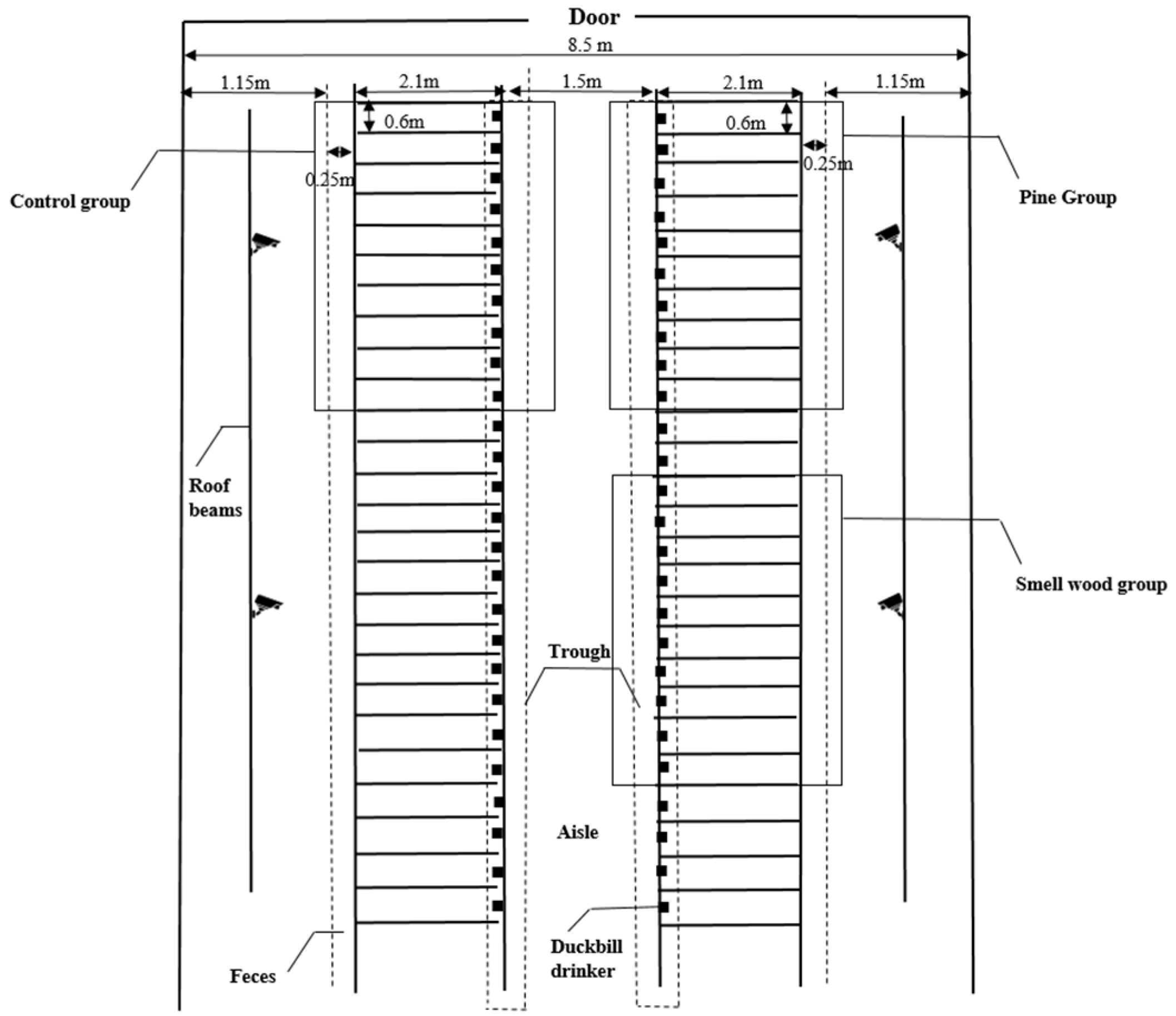

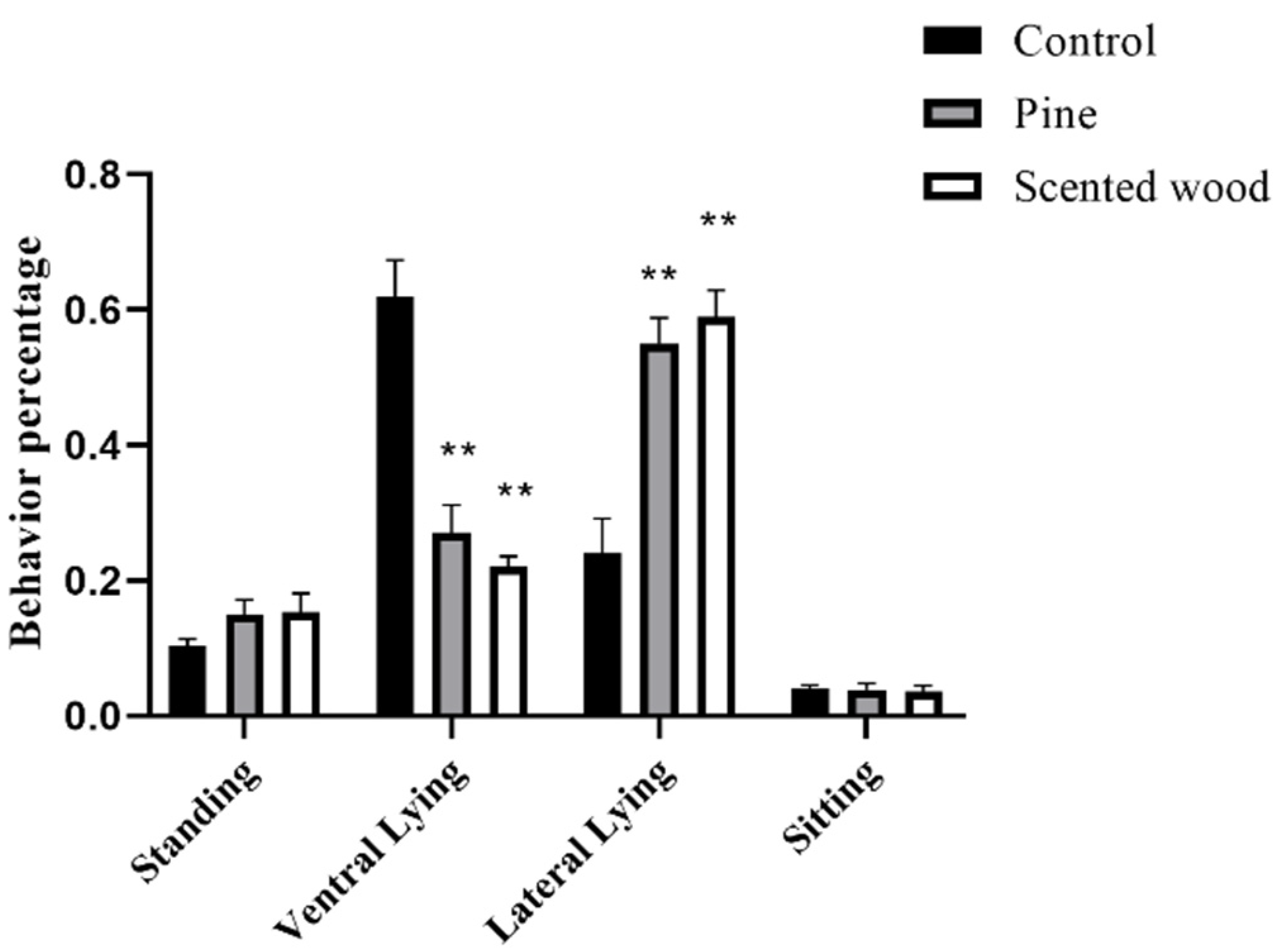
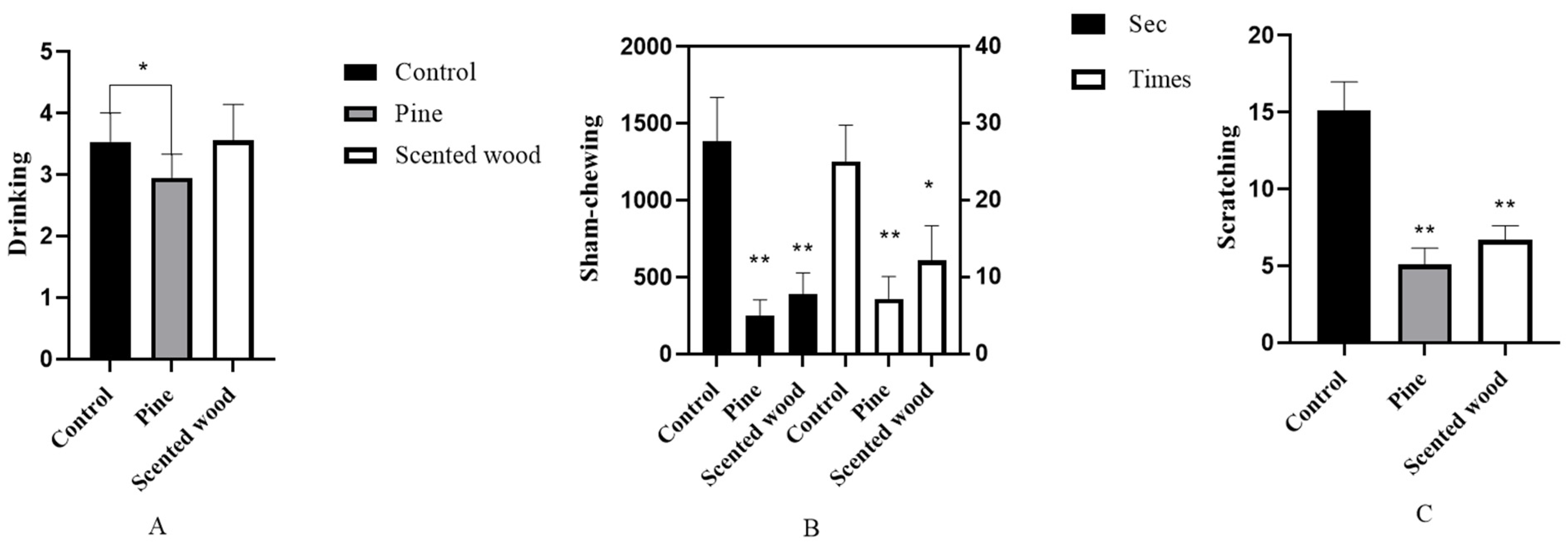
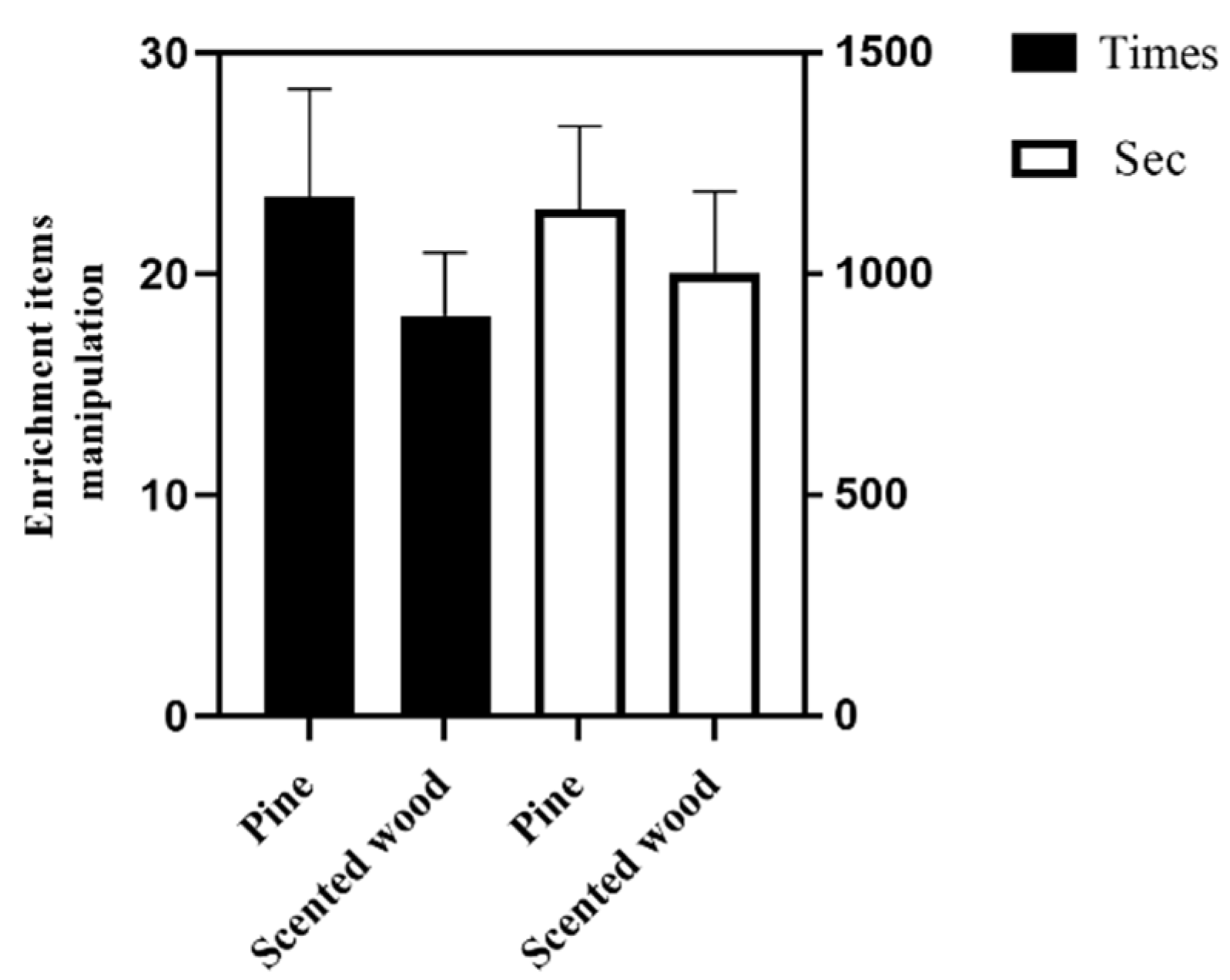
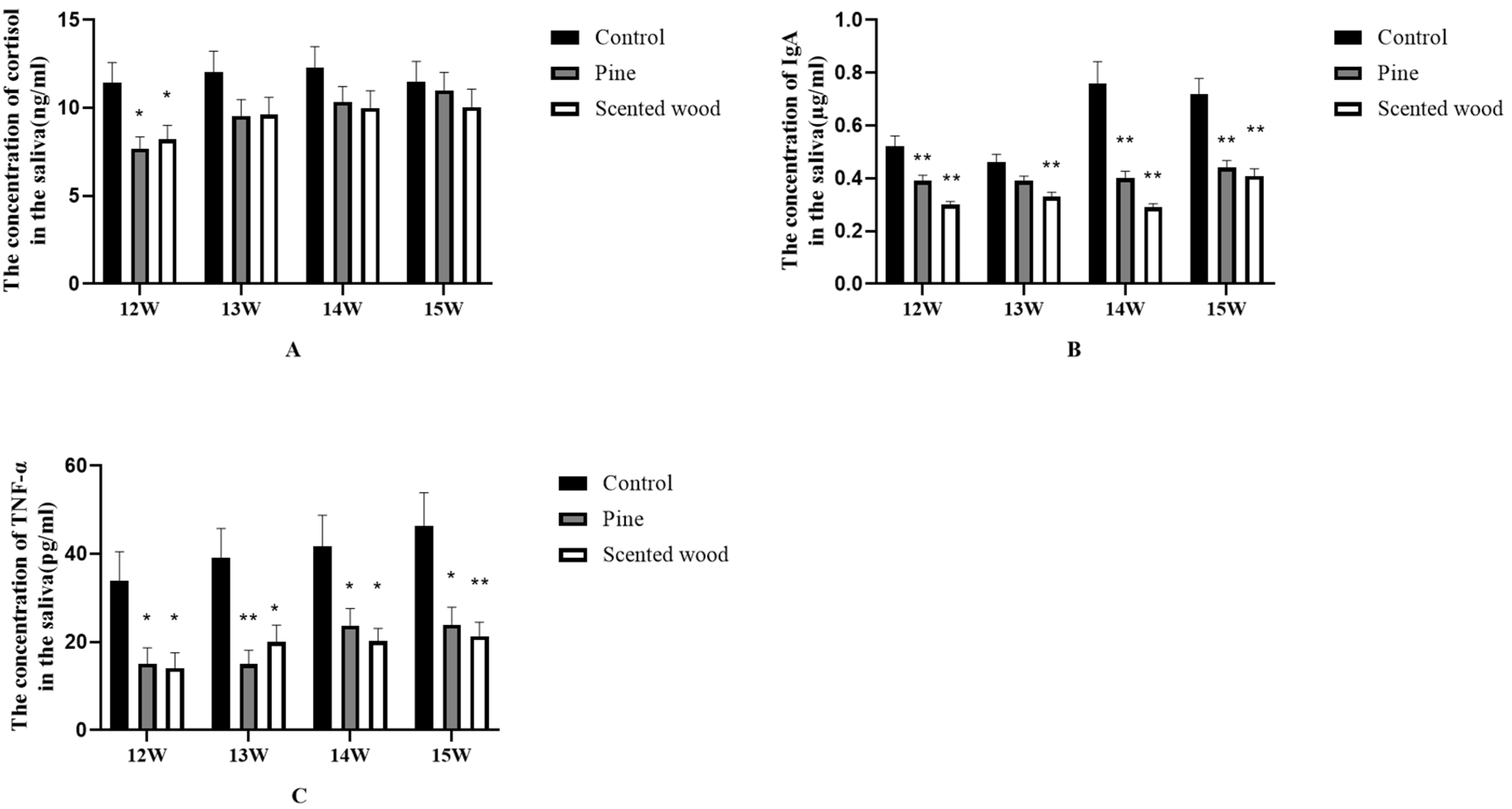
| Nutrient | Amount (%) |
|---|---|
| Crude protein (%) | 15.00 |
| Crude fiber (%) | 8.00 |
| Crude ash (%) | 10.00 |
| Calcium (%) | 1.00 |
| Total phosphorus (%) | 0.40 |
| Lysine (%) | 0.85 |
| Behavior | Description |
|---|---|
| A. Posture | |
| Standing | Supporting weight on the 4 limbs at the same time, but the forelimbs can kneel on the ground, and the limbs cannot be in the same plane |
| Lateral Lying | Lying with one shoulder on the floor, with 4 visible limbs [16] |
| Ventral Lying | Sow’s chest and abdomen touching the floor, with front legs stretched or folded under the body [17] |
| Sitting | Dog-sitting, with rear and front hooves on the floor [16] |
| B. Ingestion | |
| Drinking | Manipulating the drinker or apparently ingesting water |
| C. Stereotypic behavior | |
| Sham chewing | No food in the mouth and just oral activities with saliva |
| Scratching | Limb movements, licking, biting and rubbing [18] |
| D. Enrichment interaction | |
| Enrichment items manipulation | Arching, sniffing, chewing, and licking enrichment items |
| Scores | Description |
|---|---|
| 1 | Delivery time is 1–1.5 h, and the delivery interval is 15–20 min/head; vulva is red and swollen; breathing is slightly deepened, lying calmly on her side and slightly humming. |
| 2 | The delivery time is 1.5–3 h, and the delivery interval is 20–30 min/head; the vulva is slightly edema; the birth canal shows slight hemorrhage; the breathing is fast; she likes to move and hums from time to time. |
| 3 | The delivery time is 3–4.5 h; the delivery interval is more than 30 min/head; the vulva has severe edema, hematoma, and a small amount of bleeding, coupled with abnormal breathing, small swings, and slight shouting. |
| 4 | The delivery time is 4.5–6 h and the delivery interval is 30 min/head; the vagina shows malignant edema, hematoma, and heavy bleeding, coupled with abnormal breathing, moderate swing, and violent shouting. |
| 5 | The delivery time is more than 6 h and the delivery interval is more than 30 min/head; the vagina shows malignant edema, hematoma, and heavy bleeding, coupled with abnormal breathing, large swing, and violent shouting. |
| Control | Pine | Scented Wood | |
|---|---|---|---|
| n = 10 | n = 10 | n = 10 | |
| Number of litters | 13.11 ± 1.87 | 13.33 ± 1.05 | 12.90 ± 1.37 |
| Number of live pigs | 11.67 ± 1.25 | 12.33 ± 1.03 | 11.80 ± 1.14 |
| Number of stillbirths | 0.89 ± 0.45 | 1.00 ± 0.67 | 1.10 ± 0.43 |
| Number of mummies | 0.56 ± 0.44 | 0 | 0 |
| Birth weight | 15.20 ± 1.19 | 17.14 ± 1.39 | 16.30 ± 1.28 |
| Average birth weight | 1.36 ± 0.08 | 1.41 ± 0.07 | 1.43 ± 0.09 |
| Labor score | 2.78 ± 0.36 | 2.67 ± 0.24 | 2.40 ± 0.27 |
| Duration of farrowing | 227.22 ± 23.02 | 223.89 ± 11.72 | 214.00 ± 14.70 |
Publisher’s Note: MDPI stays neutral with regard to jurisdictional claims in published maps and institutional affiliations. |
© 2022 by the authors. Licensee MDPI, Basel, Switzerland. This article is an open access article distributed under the terms and conditions of the Creative Commons Attribution (CC BY) license (https://creativecommons.org/licenses/by/4.0/).
Share and Cite
Li, S.; Hu, H.; Huang, J.; Yang, Y.; Xu, W.; Chen, J.; Wan, J.; Li, L.; Zheng, R.; Jiang, S.; et al. Effect of Enrichment Items on the Physiology and Behavior of Sows in the Third Trimester of Pregnancy. Animals 2022, 12, 1355. https://doi.org/10.3390/ani12111355
Li S, Hu H, Huang J, Yang Y, Xu W, Chen J, Wan J, Li L, Zheng R, Jiang S, et al. Effect of Enrichment Items on the Physiology and Behavior of Sows in the Third Trimester of Pregnancy. Animals. 2022; 12(11):1355. https://doi.org/10.3390/ani12111355
Chicago/Turabian StyleLi, Shuangshuang, Hongqing Hu, Jian Huang, Yuxuan Yang, Weijing Xu, Junfeng Chen, Jiawei Wan, Lianghua Li, Rong Zheng, Siwen Jiang, and et al. 2022. "Effect of Enrichment Items on the Physiology and Behavior of Sows in the Third Trimester of Pregnancy" Animals 12, no. 11: 1355. https://doi.org/10.3390/ani12111355
APA StyleLi, S., Hu, H., Huang, J., Yang, Y., Xu, W., Chen, J., Wan, J., Li, L., Zheng, R., Jiang, S., & Chai, J. (2022). Effect of Enrichment Items on the Physiology and Behavior of Sows in the Third Trimester of Pregnancy. Animals, 12(11), 1355. https://doi.org/10.3390/ani12111355





